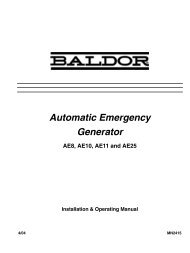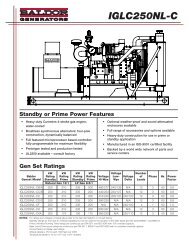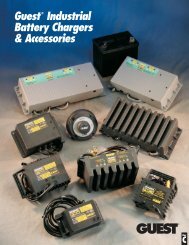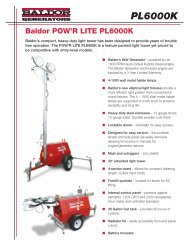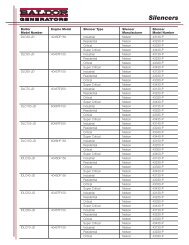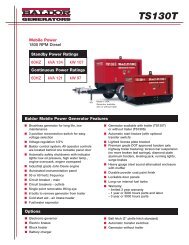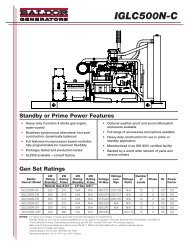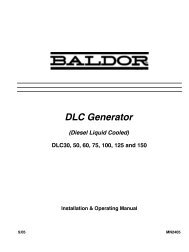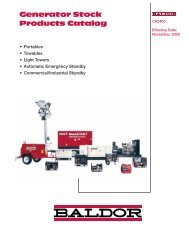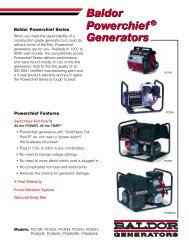Installation & Operation Manual - Phase-A-Matic, Inc.
Installation & Operation Manual - Phase-A-Matic, Inc.
Installation & Operation Manual - Phase-A-Matic, Inc.
You also want an ePaper? Increase the reach of your titles
YUMPU automatically turns print PDFs into web optimized ePapers that Google loves.
Caution: This generator must have a battery installed for operation. The battery is used during starting<br />
and during operation. If engine operation is attempted while the battery is removed, damage<br />
to the engine’s electrical components may result.<br />
Battery Connections AE8, AE10, AE11, and AE25. The generator is shipped with no battery installed.<br />
WARNING: <strong>Installation</strong> and servicing of batteries is to be performed or supervised by personnel<br />
knowledgeable of batteries and the required precautions. Keep unauthorized personnel away<br />
from batteries.<br />
WARNING: Do not dispose of battery or batteries in a fire. The battery is capable of exploding. If the<br />
battery explodes, electrolyte solution will be released in all directions. Battery electrolyte<br />
solution is caustic and can cause severe burns and blindness. If electrolyte contacts skin or<br />
eyes, immediately flush the area with water and seek medical attention quickly.<br />
WARNING: Do not mutilate the battery . The battery contains electrolyte solution which is caustic and<br />
can cause severe burns and blindness. If electrolyte contacts skin or eyes, immediately flush<br />
the area with water and seek medical attention quickly.<br />
WARNING: A battery presents a risk of electrical shock hazard and high short circuit current.<br />
The following precautions are to be followed when working on batteries:<br />
1. Remove watches, rings, necklaces and all other metal objects.<br />
2. Use tools with insulated handles.<br />
3. Wear rubber gloves and boots.<br />
WARNING: The battery electrolyte is a dilute sulfuric acid that is harmful to the skin and eyes. It is<br />
electrically conductive and corrosive.<br />
The following precautions are to be followed when working on batteries:<br />
1. Wear full eye protection (safety glasses or goggles) and protective clothing.<br />
2. Where electrolyte contacts the skin, flush the area immediately with water and wash it<br />
off using soap and water.<br />
3. Where electrolyte contacts the eyes, immediately flush the eye thoroughly with water<br />
and seek medical attention quickly.<br />
4. Spilled electrolyte is to be washed down with an acid neutralizing agent. A common<br />
practice is to use a solution of one pound (500 grams) bicarbonate of soda to one<br />
gallon (four liters) of water. The bicarbonate solution is to be added until evidence of<br />
reaction (foaming) has ceased. The resulting liquid is to be flushed with water and the<br />
area dried.<br />
WARNING: A battery presents a risk of fire because they generate hydrogen gas. Hydrogen gas is<br />
extremely explosive. Never jump start a battery, smoke in the area around the battery or<br />
cause any spark to occur in the area around the battery.<br />
The following precautions are to be followed when working on batteries:<br />
1. Do not smoke when near batteries.<br />
2. Do not cause flame or spark in battery area.<br />
3. Discharge static electricity from body before touching batteries by first touching a<br />
grounded metal surface.<br />
WARNING: Disconnect the battery’s ground terminal before working in the vicinity of the battery or<br />
battery wires. Contact with the battery can result in electrical shock when a tool accidently<br />
touches the positive battery terminal or wire. The risk of such shock is reduced when the<br />
ground lead is removed during installation and maintenance.<br />
Procedure: The correct type battery must be installed in the battery compartment provided, see Table 3-5.<br />
<strong>Installation</strong> and servicing of batteries is to be performed or supervised by personnel<br />
knowledgeable of batteries and the required precautions.<br />
Keep unauthorized personnel away from batteries.<br />
1. Open access doors and locate battery tray.<br />
2. Place the correct battery (see Table 3-5) on the tray.<br />
3. Install the Battery Hold Down Bar and Rods as shown in Figure 3-12.<br />
a. Place the bent end of the Battery Hold Down Rod through the hole in the Battery Tray.<br />
b. Place the threaded end of the Battery Hold Down Rod through the hole in the<br />
Battery Hold Down Bar and secure with flat washer, lock washer and nut.<br />
c. Repeat steps 3a and 3b for the other Battery Hold Down Rod.<br />
3-14 Receiving & <strong>Installation</strong> MN2415



